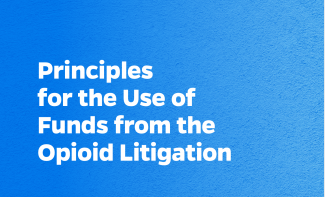
Opioid Settlement Dollars Must Be Spent Wisely. New Guiding Principles Outline How
Overdose deaths due to opioids have killed more than half a million people over the past two decades. This public health crisis has worsened during the COVID-19 pandemic, with some states reporting a 30% increase in opioid overdose deaths. But there is hope for a better future: the forthcoming state opioid settlement could help turn the tide.
As states are settling their legal cases against opioid manufacturers, pharmaceutical distributors, and pharmacies, they will hopefully be investing in science-based programs to prevent and treat opioid addiction. States and counties are in desperate need of increased resources to help address the current opioid epidemic and prevent future addictions.
Jurisdictions will face difficult decisions in determining how to use their settlement money.
Fortunately, an expert panel recently released a report that provides a helpful roadmap that states, cities and counties can use to guide them through this process.
Today, Shatterproof joins with public health colleagues led by the Johns Hopkins School of Public Health to announce guiding principles for the use of the opioid abatement funds. We lay out five key principles that states and localities should use when determining how to spend the money.
The most urgent principle is this: States must develop a fair and transparent process for how these settlement dollars will be spent. It is not a given that states will spend this money on science-based programs to prevent and treat addiction. As noted with the past tobacco settlement, only 2-3% of the dollars were spent on nicotine prevention and cessation programs.
Building and implementing a transparent process is critical to ensuring this history is not repeated with the opioid settlement.
Some states, like Colorado and New Hampshire, have enacted policy to create a special opioid abatement fund so that these dollars don’t go directly into the state’s general treasury. Other states have included a reporting mechanism in that process so that allocation amounts and outcomes can be reported back to the state. Texas came to an agreement with their counties on allocation and distribution of funds by locality.
It will be up to the states to determine these practices. Shatterproof is alerting stakeholders and elected officials so that a transparent process to allocate opioid settlement dollars can be enacted in all 50 states.
Click here to read the recommendations.
Then sign our petition urging state officials to spend settlement dollars on science-based addiction programs. This could be a big opportunity to get more science-based treatment and prevention programs into our communities—and to save countless lives. Together, we can make it happen.




